Using a cargo van as the platform to build out a camper van is super popular these days, and we can understand why! Commercial vans make great bones for little RVs and can be customized to include pretty much anything a traveler/camper wants to accommodate. With the introduction of the 2022 Ford Transit electric van (also known as the Ford E-Transit), we’re pretty sure there are more than a few adventurers with an eye on transforming one of these babies.
We recently took a look at electric RVs as a general concept, electric vehicle towing capacity, and whether electric vehicles can be flat towed behind a motorhome. Now let’s take a look at the Ford Transit all-electric van to see how it shakes out as a camper van!
- 1) What Is the Ford Transit Electric?
- 2) What Is the Range of the Ford Transit Electric?
- 3) Can We Buy a Ford Transit Electric Van to Build Out as a Camper?
- 4) Could the Ford Transit Electric Be Charged With Solar Panels?
- 5) Could the Ford Transit Electric Be Charged With a Generator?
- 6) Are There Other All-Electric Vans in Production?
- 7) What Are the Advantages of All-Electric Vans?
- 8) Would You Be Interested in Building Out a Ford Transit Electric as Your Camper Van?
What Is the Ford Transit Electric?
The Ford Transit Electric, or Ford E-Transit, is the all-electric version of Ford’s best-selling van, the Ford Transit (already a popular platform for Class B RVs and van conversions). The E-Transit is the first all-electric cargo van from a full-line automaker in North America.
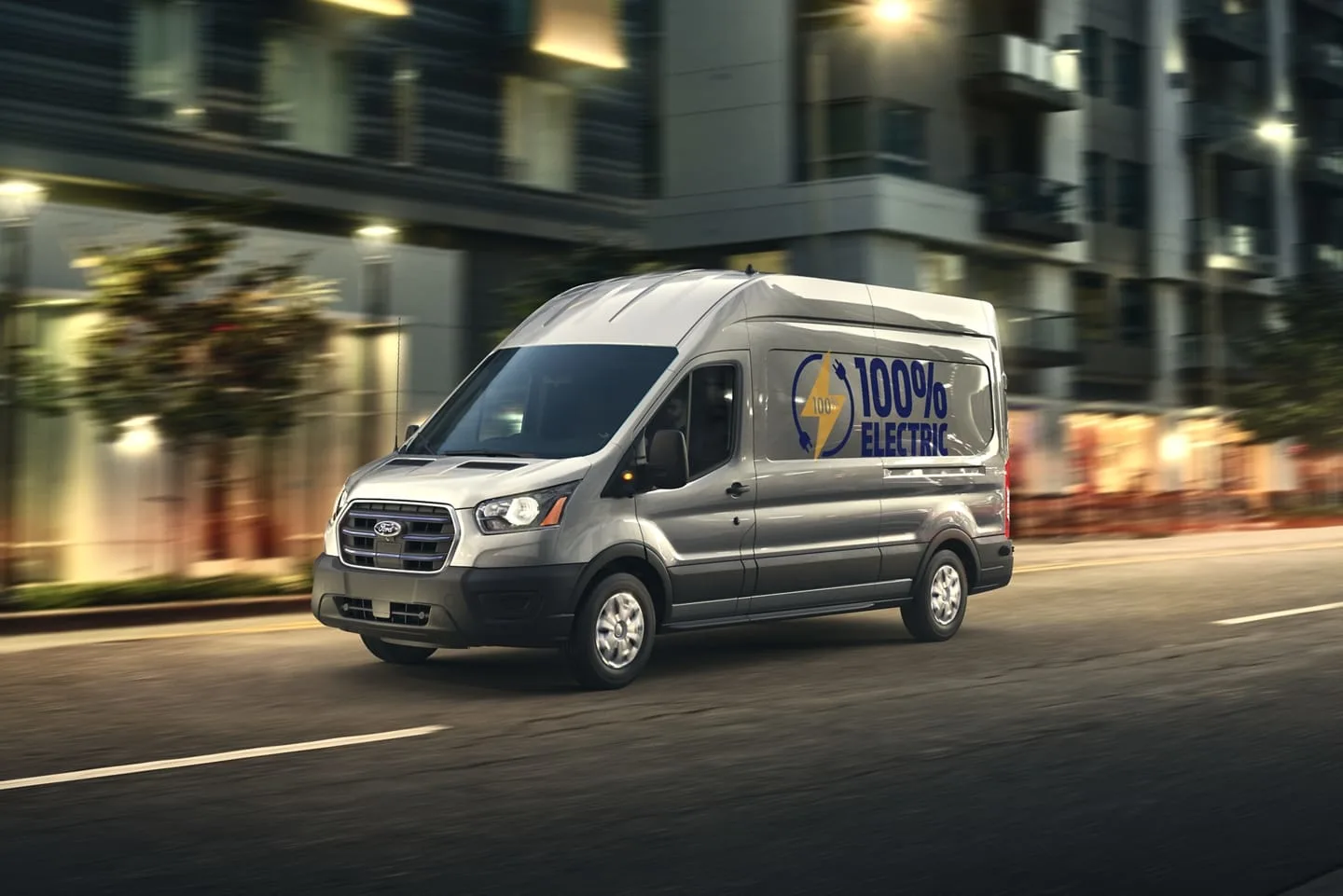
Introducing the Ford E-Transit – the first all-electric cargo van from a full-line automaker in North America. (Photo credit: Ford Motor Company)
With the E-Transit, Ford introduces an all-new electric work van with an entire ecosystem of products built to serve a wide range of commercial industries, including (and perhaps especially) the delivery industry.
The E-Transit is built alongside the traditional Ford Transit work van at Ford’s Kansas City assembly plant. Customers are offered a choice of eight configurations, including a cargo van with three roof heights and three lengths, as well as chassis cab and cutaway versions.
The E-Transit is the first of two all-electric vehicles being built by Ford Pro for commercial customers in 2022.
What Is the Range of the Ford Transit Electric?
The targeted range of the low-roof cargo van models of the E-Transit is 126 miles. Yup – that’s low. However, Ford looked at 30 million miles of their Telematics data and learned that the average daily driving range for commercial vans in the United States is only 74 miles. They adjusted for variations and for things like cold weather and ultimately designed the Ford Transit Electric low-roof cargo van with a targeted range of 126 miles.
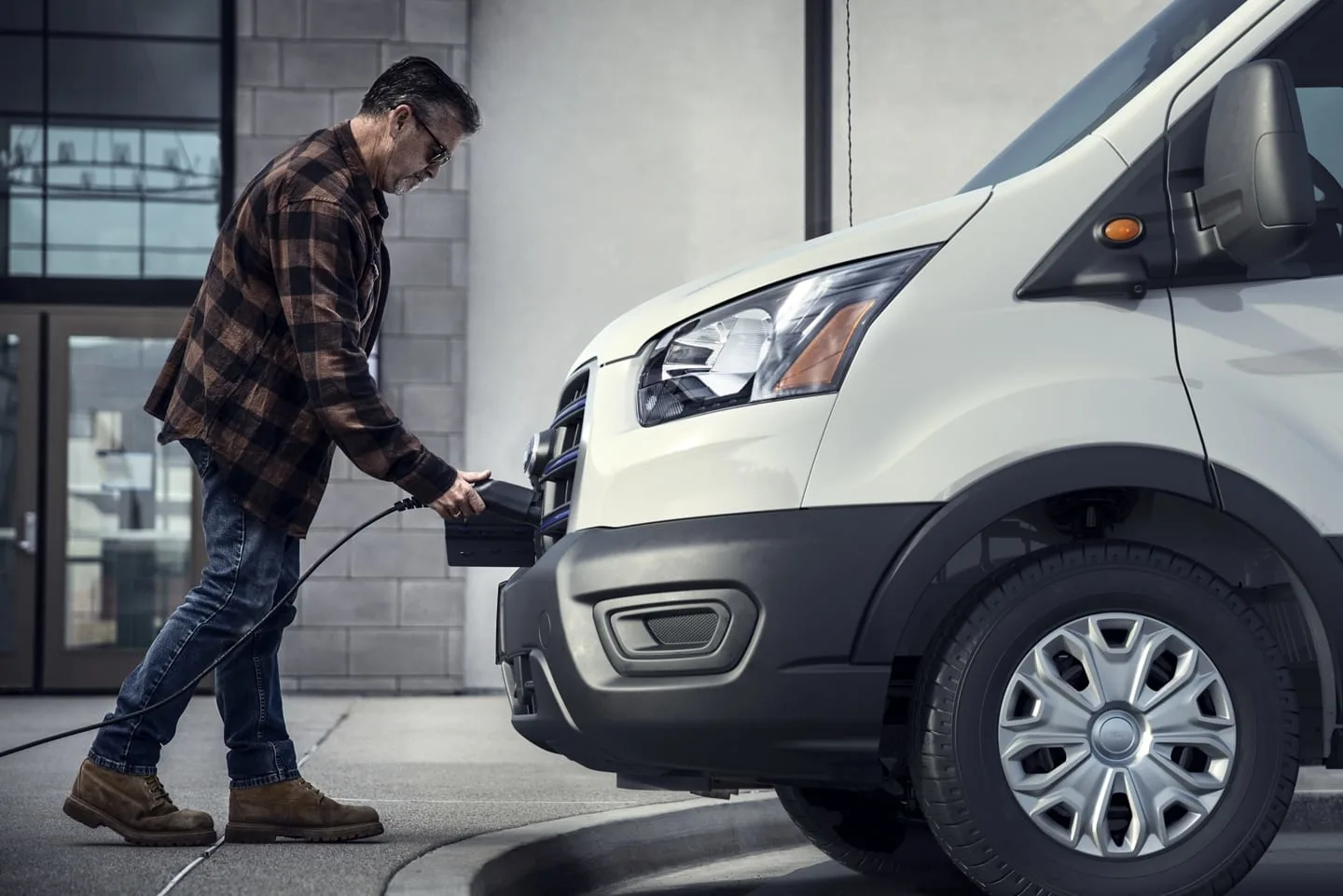
Though the targeted range of the low-roof cargo van models of the E-Transit is 126 miles, Ford contends that this is a reasonable range for commercial vehicles, and they’re working on increasing both capability and range. (Photo credit: Ford Motor Company)
Ford has stated that they’re working on offering more capability and greater range, and plan to announce those upgrades in the future. This may be a good reason to hold off on converting a Ford Transit electric van to an RV.
Can We Buy a Ford Transit Electric Van to Build Out as a Camper?
Well, sure. You could buy a Ford E-Transit to build out as a camper. The real question is – would you want to? Let’s take a look at the two biggest issues we foresee as being particularly difficult to navigate.
Access to Charging Stations
Access to charging stations is a real issue for RVers who wish to travel in an all-electric vehicle. The e-vehicle charging infrastructure is improving, but it’s not out there on as grand a scale as we’d hope to see if we were driving an all-electric rig.
And remember – you may need to charge your E-Transit when you’re in an area that’s far away from the current charging network here in North America. If you want to build out a little rig for adventuring and camping, chances are that you’ll be taking it outside of that network.
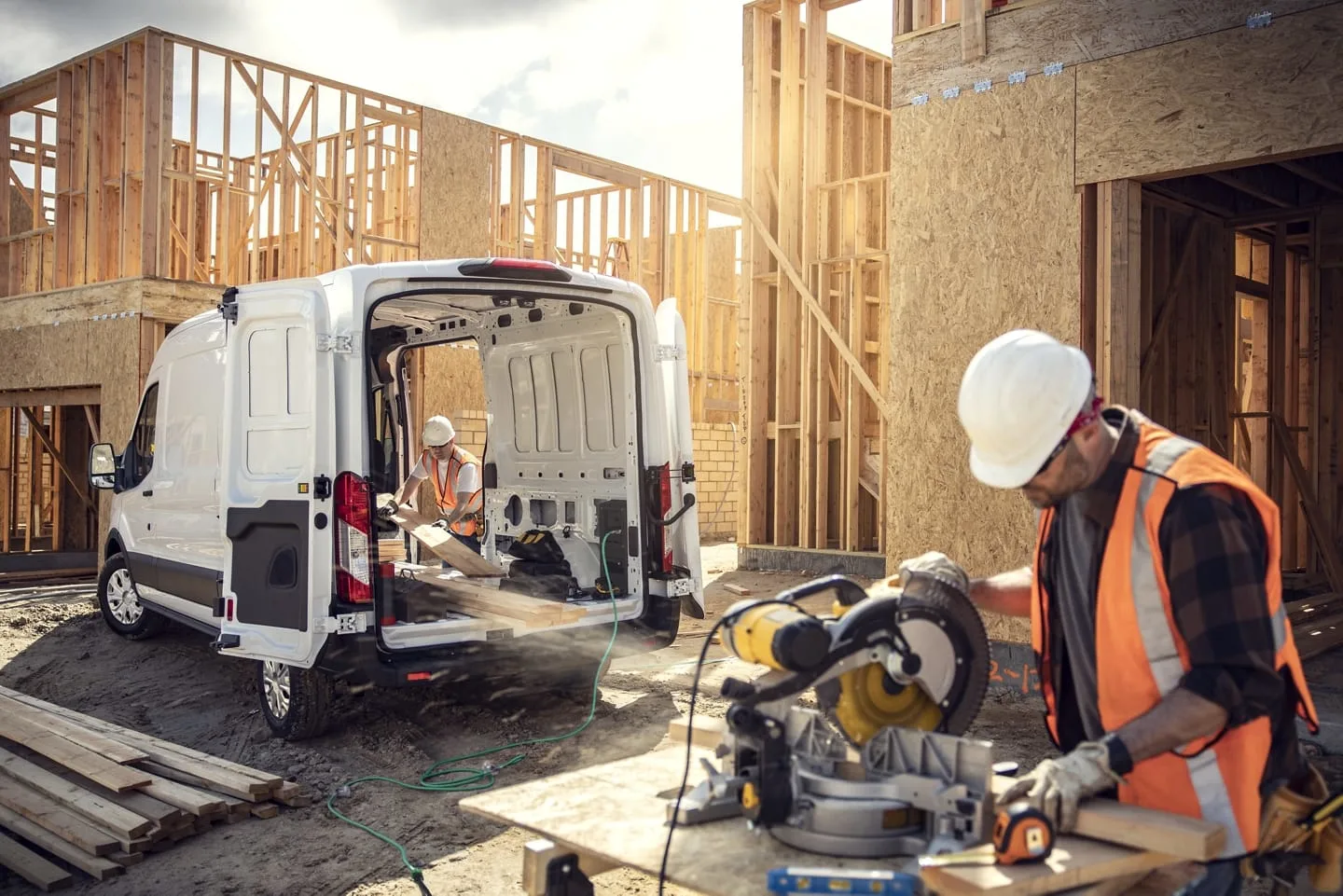
Ford’s e-Transit vans offer a fair range and a sufficient network of charging stations for commercial applications. But a camper van would require improvements in both areas. (Photo credit: Ford Motor Company)
While the current network of charging stations might work fine for delivery vans and other commercial uses of cargo vans in certain areas of the country, that same network likely won’t offer charging stations in remote areas where an RVer needs to recharge.
It would also take a fair amount of time to recharge an all-electric camper van at current charging stations.
Payload Issues Impacting Range
Another serious consideration is the payload capacity of these cargo vans. The payload of a work van (including a delivery van) and the payload of an RV are two different animals.
RVers need to carry seats, a bed, water (at 8.34 pounds per gallon), a propane tank, possibly a generator (especially if you’re venturing away from the charging network), a refrigerator, batteries & possibly solar panels, and lots of gear. That’s a lot of weight, and that’s going to impact your driving range.
Ford isn’t yet making a passenger van version of the E-Transit, probably because a fully-loaded 15-passenger van would require more payload than even a fully loaded cargo van… and the resulting driving range would be heavily impacted.
The Ford E-Transit cargo van is not designed to carry 15 seats with passengers, and it’s not really designed to carry a little home-on-wheels + gear, either.
Now, you could argue that all the Ford Transits that have been transformed into campers weren’t designed for that purpose either. But stopping at a gas station for fuel – diesel or gasoline – isn’t as problematic as locating a charging station and getting to it before your battery lets you down.
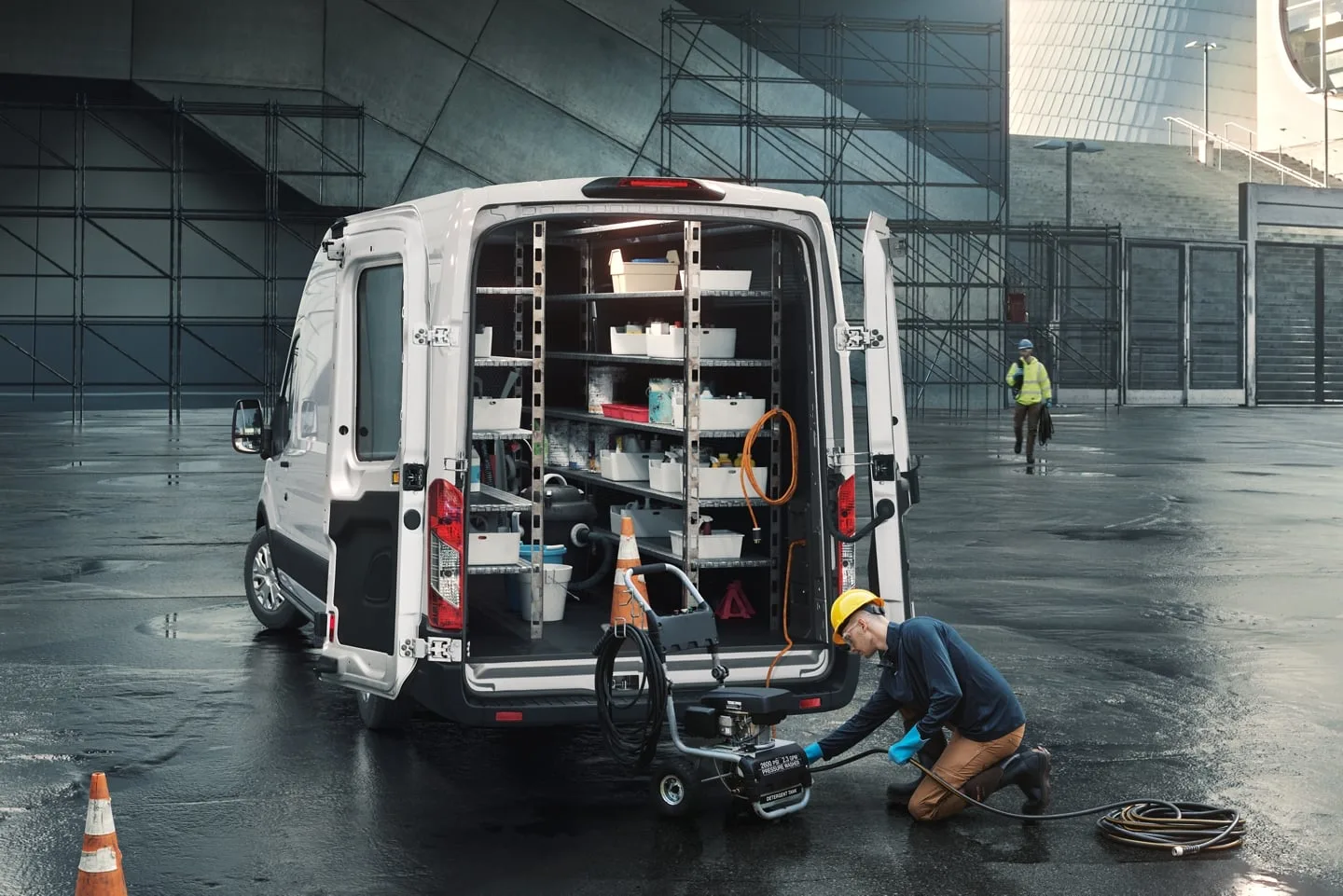
The payload of a commercial work van or delivery truck is very different from that of a camper van. (Photo credit: Ford Motor Company)
We can only imagine how the additional weight of equipment and gear for an RV conversion would impact the driving range of the E-Transit. Surely the range would be far less than the targeted 126 miles (which is already low for an RVer). Even given a sufficient charging network in the area where you’re traveling, stopping every 100 miles or less to recharge would be annoying at best. And impossible at worst.
With all of that said, though, Rivian has their fully-electric R1T pickup truck that can carry five people plus their bikes and gear up to 440 miles on a single charge, and their R1S SUV that can carry seven passengers. That’s not half bad! (Depending on the model and options, though, the range technically varies from 260+ miles to 440+ miles per charge.)
Rivian achieves this status with a rechargeable battery pack at the center of the chassis and a separate 200hp electric motor for each wheel.
So, the potential is there and things are evolving but there’s a reason (probably several) why Ford is starting with commercial cargo vans.
Could the Ford Transit Electric Be Charged With Solar Panels?
It’s possible! An e-vehicle can be charged using solar power (our friends, Tom & Cait Morton, charge their Chevy Volt from their fifth-wheel’s solar). But it might require a lot of time and a lot of batteries & solar panels, particularly if you’re also planning to power the interior of your RV/camper van with that solar as well.
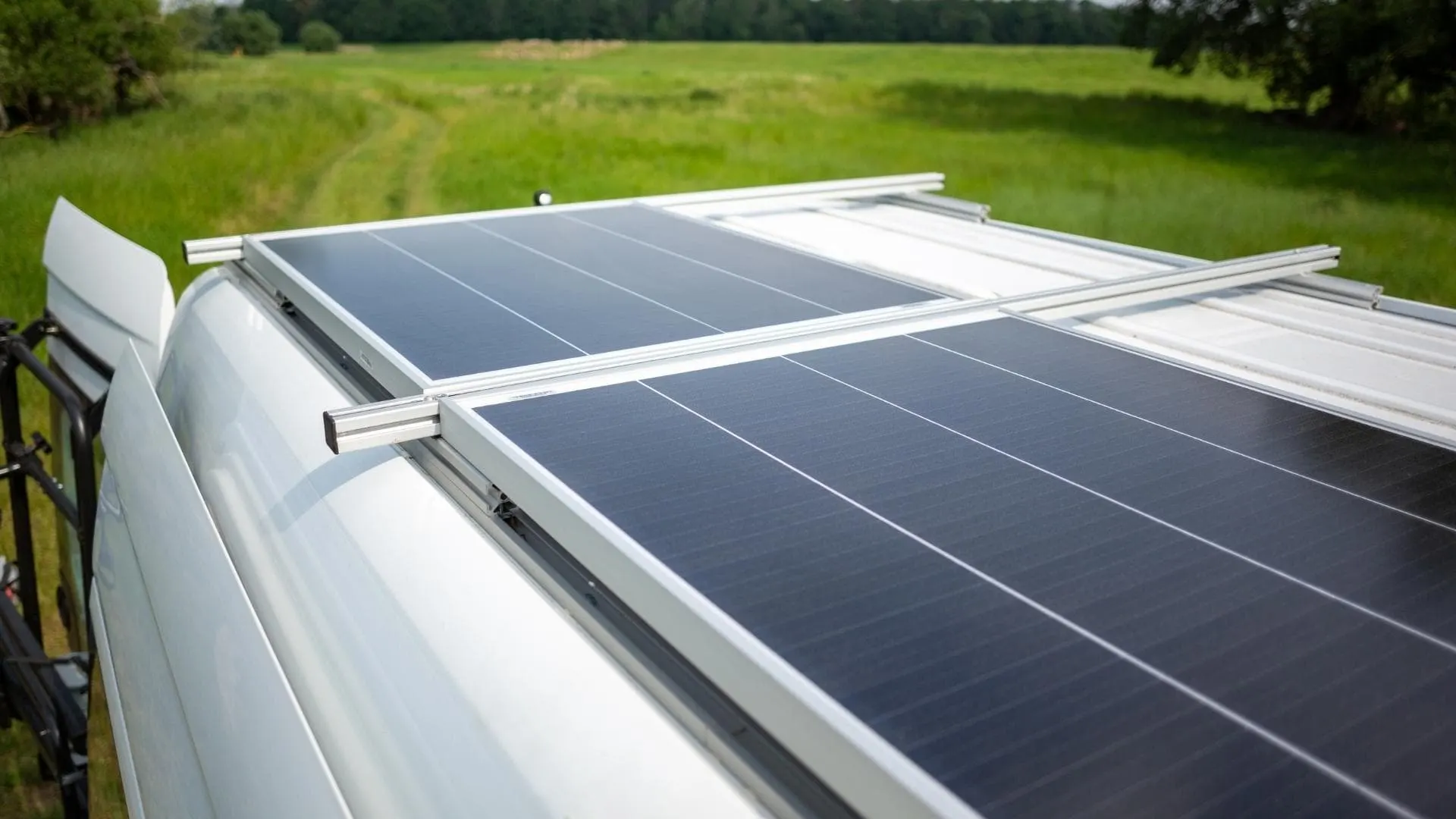
The potential is there for a Ford e-Transit and other all-electric camper vans to be charged via solar panels…in the not-too-distant future.
There are companies exploring the possibility of integrating solar panels into cars to provide power as you go. They face some obstacles, however. In fact, Toyota’s Prius Prime (available only in Japan) uses integrated solar panels. The integrated panels add UP TO 3.7 miles of driving range per day, while parked. That’s not a lot for a car… and even less helpful for an RV traveling long distances.
So again, a lot of solar panels would be required to charge a vehicle like the Ford Transit Electric. And where would you put them?
Could the Ford Transit Electric Be Charged With a Generator?
You could, but what would be the point? You’ve got an all-electric vehicle and you’re going to carry a gas generator and some gas cans full of fuel to charge it? Hmmm…this would seem to defeat a few purposes of an electric vehicle (although, admittedly, gas/diesel-powered generators can run more efficiently when running at a constant, optimal speed to generate electricity).
Moreover, while the generator might be capable of charging your Ford Transit Electric, it would take a lot of time. The charging stations on the Tesla network, for example, are superchargers providing hundreds of amps of charging current at very high voltage. Your generator wouldn’t be capable of charging the van’s batteries faster than driving would deplete them.
So, once again, the charging infrastructure isn’t quite where it needs to be to make an all-electric camper van completely self-sufficient off the grid.
Are There Other All-Electric Vans in Production?
There are already many electric vans traveling to and from work sites across Europe. And Rivian-built Amazon vans are already on the road in the U.S., with another half-dozen all-electric vans coming to American roads in the near future to join the Ford Transit Electric.
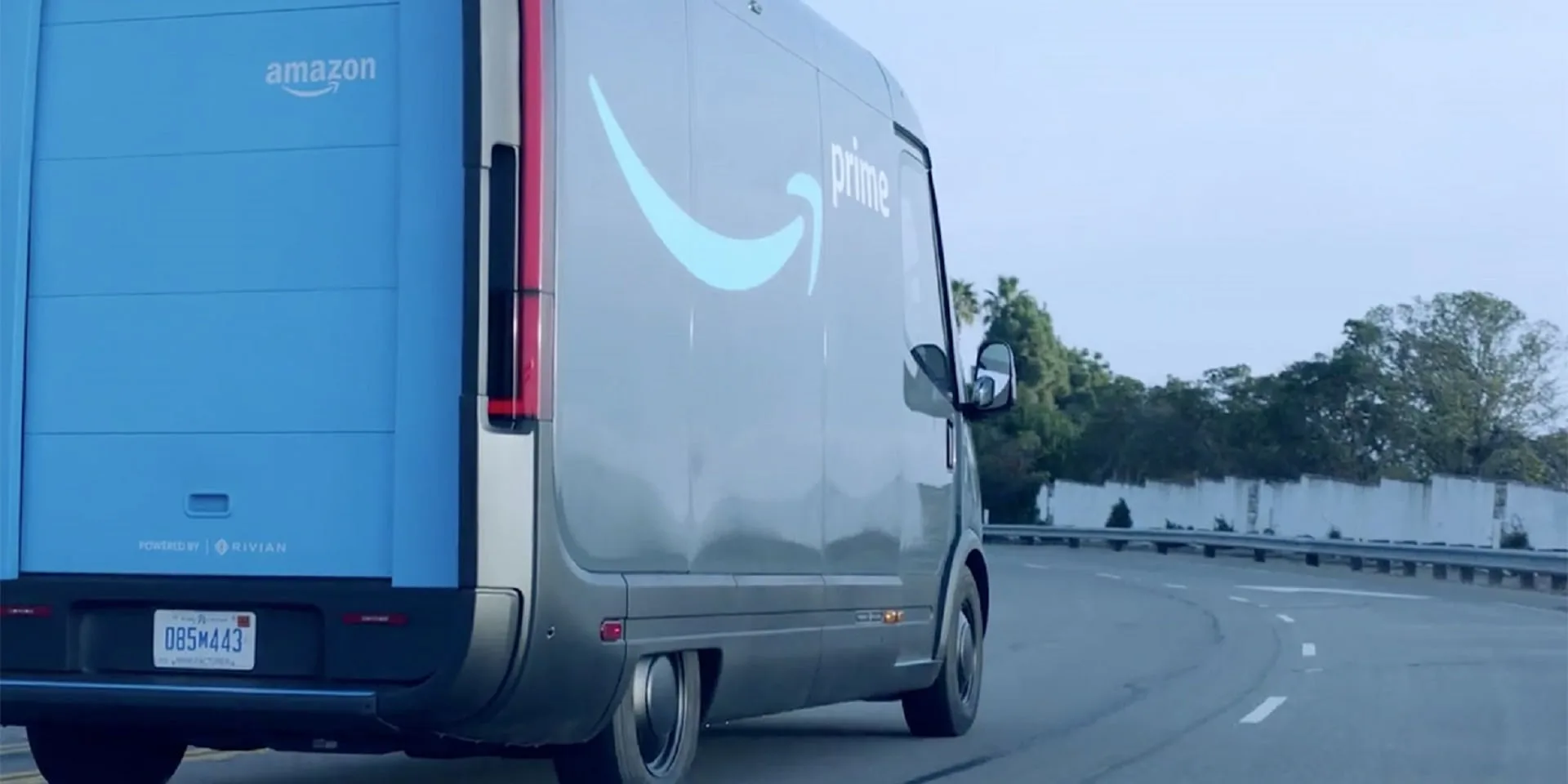
All-electric Amazon delivery trucks built by Rivian are already on the road in the U.S. (Photo credit: Fleet Equipment Magazine)
What Are the Advantages of All-Electric Vans?
In addition to not using fuel, electric vehicles are projected to be more reliable and less expensive to maintain than their fuel-powered counterparts. They also incorporate a lot of safety technology such as automatic emergency/pre-collision braking, lane-keeping assistance, pedestrian detection, and forward-collision warnings.
Electricity rates are also (typically) more predictable than oil prices. Though with increased demand placed on the electrical grid from EV charging, this could change, too.
And with regard to delivery vans in particular, they travel so few miles per day in general, that the impact of charging requirements is far less than it would be for an RVer.
Would You Be Interested in Building Out a Ford Transit Electric as Your Camper Van?
So, tell us – would you be interested in building out a Ford Transit Electric as a camper van for your adventures? Why or why not? We’d love to know!
Geek Out With Us Every Week
Join our newsletter to learn about all things RV-related. Every week we offer free tips, tricks, product reviews, and more to our online community of RVers. So, whether this is your first time on the road or you’re a seasoned expert, we’d love for you to geek out with us!


Jon
Thursday 11th of April 2024
I've thought about it, and I know FedEx in Toronto has just got them. But the latest fiasco with EVs not charging in the cold, left me, well ... cold. :) Besides, the Japanese are working on a synthetic fuel that will run combustion engines. That would be very nice, especially if it ends up cheaper than gasoline.
C-Love
Sunday 18th of June 2023
Something I don't see discussed here- these ranges are calculated at highway speeds. Efficiency on EV's is entirely linearly regressive- meaning the slower you go the farther you can go. I'm willing to wager the range can be nearly doubled if you can find scenic roads and keep to slower speeds. Enjoy the ride! Couple this with 2x the roofs surface area in high grade solar panels, and you could recoup your battery charge in a matter of days. While not ideal for some- the allure energy independence will certainly eclipse these minor inconveniences which can be planned around when choosing your routes.
David
Sunday 17th of December 2023
@C-Love, I drove from California to Brazil in an EV (Chevy Bolt). By driving slowly and letting off the accelerator a little on uphills and taking maximum advantage of regeneration on downhills I got approximately 25% more range than the 259 miles rated for the Chevy Bolt. But I don't think 50% more would be possible unless you're on a substantially downhill stretch. Would be nice :)
Martin
Wednesday 2nd of November 2022
I agree that 126 miles of range (probably nearer 110 in the high-roof version that is popular for camper-vans) is probably too low for most people for a camper-van. However, I do not think the weight of a camper-van conversion would have as much impact on range as you suggest. Range of an electric vehicle is much more dependent on wind resistance than on vehicle weight, so if you avoid adding a roof-rack and other modifications that affect wind resistance, your range will probably be similar to the manufacturer's claims, even with the added weight of a van conversion.
Jim
Wednesday 10th of April 2024
@Martin, Range is dependant on wind, rain and temperature. I own a 148" Ext high roof and have seen as high as 150 miles on warm, sunny, and calm days. If the temperature goes below 40 F, raining and windy, I may get 100 miles. Weight never seemed to change mileage as much as the other three factors. 20,000 miles and counting
Leslie
Saturday 11th of November 2023
@Martin, I think you're right. Also, I just learned that they based their range numbers on carrying 1500 lbs of payload.
Kel
Friday 15th of July 2022
I've been considering it actually because we're in MI and ny MIL is retired Ford so we get a discount on the vehicle. Range is disappointing as I would still like to see Ford come out with an all electric 7 passenger vehicle with range comparable to the Mach E (which we have and love) or the F150 Lightning. So we know it's possible Ford just needs to build it.
Paul Roberts
Monday 11th of April 2022
We've got our Newmar Class A toy hauler (Gas model) loaded with solar on the roof (12 panels each at 190w). I'm not worried about getting a Van conversion that is all-electric. I want an electric car that I can tow flat-four. It irks me that I have a gas pump in the vehicle (It's a toy hauler, but I use the garage as my office). I want to switch that out for an electric vehicle charger so our toad can be electric and be charged. We are in a Forest Service site near Carlsbad Caverns, and we are pulling down 2,000 watts of energy. The system doesn't quite offset the two A/C units, computer and refrigerator pulling energy off it right now, but it's not too far from it. Are we ten years from seeing all the all-electric van conversion or my mythical electric flat tow vehicle? No way, maybe 2-3 years. At that point it may still be crazy expensive, but it's coming sooner than lots of folks think. Already, electric vehicle sales in both Europe and China far outpace us here in the USA. That van may come from Rivian, VW, Tesla, or Ford. It's a future I'm excited about!